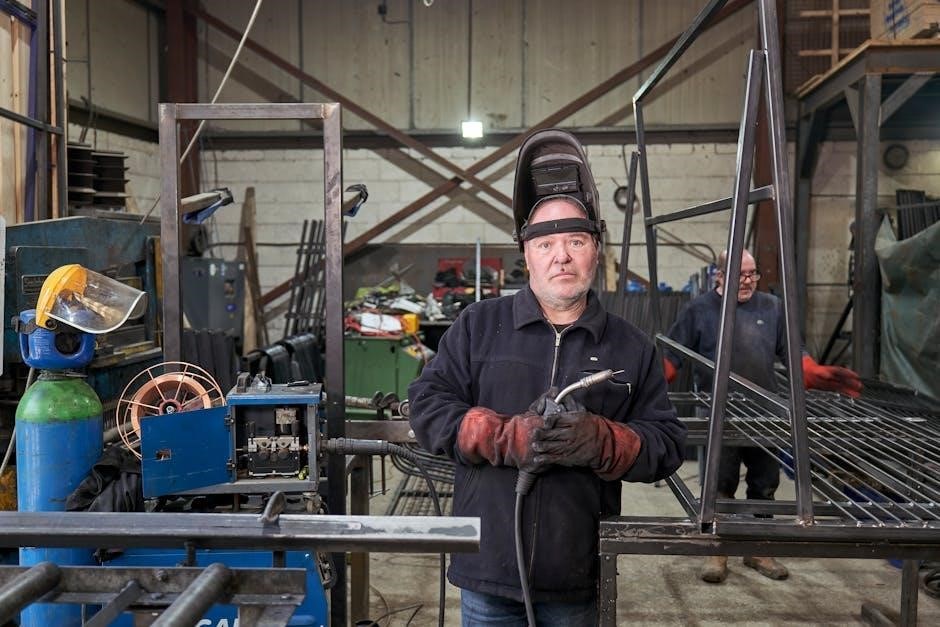Welcome to the Espar Bunk Heater Manual, your essential guide for safe and efficient installation, operation, and maintenance of Espar diesel-fired heating systems. This comprehensive resource provides detailed instructions and safety guidelines to ensure optimal performance and longevity of your heater. Whether you’re a new user or an experienced technician, this manual offers clear, step-by-step guidance for troubleshooting, maintenance, and proper usage. Designed for comfort and reliability, Espar bunk heaters are ideal for vehicles, offering consistent heat in cold conditions. Follow this manual carefully to maximize efficiency and ensure safe operation.
1.1 Overview of the Espar Bunk Heater System
The Espar Bunk Heater System is a diesel-fired heating solution designed for vehicles, providing reliable warmth in cold conditions. It is compact, efficient, and built for mobile applications, ensuring comfort in trucks, buses, and recreational vehicles. The system includes a heater unit, fuel connections, and control mechanisms, engineered for safety and performance. Suitable for various vehicle types, it offers consistent heating without relying on the engine, making it ideal for long drives or stationary use. Its design ensures low emissions and energy efficiency, meeting environmental standards while delivering optimal heat.
1.2 Importance of Reading the Manual
Reading the Espar Bunk Heater Manual is crucial for safe and proper installation, operation, and maintenance. It provides essential safety precautions, installation guidelines, and troubleshooting tips to ensure optimal performance. Understanding the manual helps avoid potential hazards, such as improper fuel connections or ventilation issues. It also ensures compliance with manufacturer recommendations, preventing voidance of warranties. By following the manual, users can maintain efficiency, troubleshoot common issues, and extend the heater’s lifespan. Always refer to the manual before attempting any installation or repair to guarantee safe and effective operation.

Key Features and Benefits of Espar Bunk Heaters
Espar bunk heaters offer high efficiency, compact designs, and reliable performance. They provide consistent heat in cold conditions, ensuring comfort and reducing engine idling. With advanced safety features, low emissions, and CARB certification, these heaters are environmentally friendly and compliant with industry standards, making them a top choice for vehicles needing auxiliary heat.
2.1 Compact Design and High Efficiency
Espar bunk heaters are renowned for their compact design and high efficiency, making them ideal for installation in tight spaces within vehicles. Their sleek dimensions allow for flexible mounting options while delivering powerful heating performance. With advanced fuel-efficient technology, these heaters minimize fuel consumption, reducing operational costs and environmental impact. The compact design also enables easy installation in various vehicles, including trucks, buses, and marine applications, without compromising interior space. This combination of efficiency and size makes Espar heaters a practical and reliable choice for auxiliary heating needs.
2.2 Safety Features and certifications
2.2 Safety Features and Certifications
Espar bunk heaters are designed with advanced safety features, including overheat protection, flameout detection, and child-safe controls, ensuring reliable and secure operation. They meet stringent industry standards, holding certifications like CARB and ULEV II for low emissions. These heaters are built to prevent hazards such as fuel leaks and electrical malfunctions. Proper installation by certified professionals is required to maintain safety. Always follow guidelines to avoid risks in hazardous environments, ensuring compliance with all safety regulations for optimal performance and user protection.

Safety Guidelines for Installation and Operation
Adhere to all safety guidelines to ensure proper installation and operation. Turn off the heater during refueling and avoid installing in enclosed areas with combustible fumes.
3.1 General Safety Precautions
To ensure safe operation, always follow these guidelines: Turn off the heater during refueling and avoid installation in enclosed areas with combustible fumes. Never install heaters in marine engine compartments or near flammable materials. Ensure proper ventilation to prevent carbon monoxide buildup. Only qualified personnel should perform installation and maintenance. Always refer to the manual for specific instructions and adhere to all safety warnings to prevent accidents and ensure reliable performance.
3.2 Hazardous Locations and Installation Restrictions
Avoid installing Espar bunk heaters in hazardous locations such as enclosed areas with combustible fumes, near flammable materials, or in marine engine compartments. Installation in these environments poses significant safety risks. Heaters must not be placed where gasoline, propane, or other volatile substances are stored or used. For marine installations, consult a certified Espar Marine dealer to ensure compliance with safety standards and regulations. Always adhere to these restrictions to prevent accidents and ensure safe operation.
Installation Requirements and Preparation
Ensure you have all necessary tools and materials for a safe and proper installation. Prepare the mounting area, following all safety guidelines and manufacturer recommendations to avoid complications.
4.1 Tools and Materials Needed
To install your Espar bunk heater, gather essential tools like a drill, wrench, screwdrivers, and pliers. Required materials include mounting brackets, screws, grommets, and sealants. Ensure you have a voltage tester for wiring connections and protective gear like gloves and safety glasses. Proper preparation of these items ensures a smooth and safe installation process, minimizing potential issues and ensuring compliance with manufacturer guidelines. Always refer to the manual for specific tool recommendations tailored to your heater model.
4.2 Mounting Angle and Positioning Guidelines
Proper mounting is crucial for safe and efficient operation. The Espar bunk heater can be tilted up to 30 degrees and rotated 90 degrees around its axis. Ensure it’s positioned to avoid obstructing airflow and exhaust. Never install in enclosed areas with combustible fumes or marine engine compartments without certification. Always follow manual guidelines for correct placement and leveling to prevent hazards and ensure optimal performance.
Step-by-Step Installation Process
Follow a structured approach: position the heater, connect fuel and wiring, and set up exhaust and intake systems. Ensure all connections are secure and meet safety standards.
5.1 Physical Placement of the Heater
Proper placement is crucial for safe and efficient operation. Mount the heater in a well-ventilated area, ensuring it is level and securely fastened. Avoid installing near flammable materials or in enclosed spaces where fumes may accumulate. The heater can be tilted up to 30 degrees or rotated 90 degrees, depending on the application, but always follow the manufacturer’s guidelines for allowable mounting angles and positions. Ensure clearance from combustible materials and proper airflow for optimal performance and safety.
5.2 Fuel Source and Wiring Connections
Ensure the fuel source is compatible with the heater, typically diesel, and connect it securely. Use the correct voltage (12/24V) and wiring as specified in the manual to prevent electrical issues. Secure all connections with appropriate materials to avoid leaks or shorts. Always inspect the fuel lines and wiring for damage before operation. Proper connections ensure safe and efficient heater performance, preventing potential hazards. Follow the manual’s guidelines for a reliable and trouble-free setup.
5.3 Exhaust and Combustion Air Intake Setup
Properly install the exhaust system using approved materials, ensuring it is well-insulated and leak-free. The combustion air intake must be positioned to avoid obstructions and ensure adequate airflow. Follow the manufacturer’s guidelines for routing and securing both components. Correct setup prevents carbon monoxide buildup and ensures efficient burner operation. Always test the system after installation to confirm proper function and safety. Adhere to local regulations and safety standards for a reliable and hazard-free heating system.

Maintenance and Service Recommendations
Regular maintenance ensures optimal performance and longevity of your Espar bunk heater. Schedule annual inspections, clean filters, and replace worn parts promptly. Adhere to the manual’s guidelines for servicing to maintain efficiency and safety, preventing potential issues before they arise.
6.1 Routine Cleaning and Inspection
Regular maintenance is crucial for optimal performance. Clean the air filter every 100 hours and inspect for blockages. Check hoses, fuel lines, and electrical connections for damage. Ensure the exhaust system is free from obstructions. Refer to the manual for specific intervals. Use appropriate tools to avoid damaging components. Routine inspection helps prevent malfunctions and ensures safe operation. Addressing issues early extends the heater’s lifespan and maintains efficiency.
6.2 Replacing Parts and Filters
Regularly replace worn-out components and filters to maintain heater efficiency. Use genuine Espar parts to ensure compatibility and safety. Replace the air filter every 100 hours or as needed. Inspect combustion components for soot buildup and clean or replace them. Follow authorized procedures for part replacements to avoid system damage. Refer to the manual for specific replacement intervals and guidelines. Always turn off the heater before performing any maintenance to ensure safe operation.

Troubleshooting Common Issues
Troubleshoot common issues by identifying faults and error codes. Refer to the manual for diagnostic steps and solutions to resolve operational problems efficiently and safely.
7.1 Diagnosing Faults and Error Codes
Diagnosing faults in Espar bunk heaters involves checking error codes displayed on the control panel. Common issues include ignition failures, fuel supply problems, and overheating. Always refer to the manual for specific code meanings. Ensure the heater is turned off during diagnostics. Check fuel lines for blockages and verify proper ventilation. Consult the troubleshooting section for step-by-step solutions to resolve issues quickly and safely, ensuring optimal heater performance and reliability.
7.2 Solving Common Operational Problems
Common issues with Espar bunk heaters include poor airflow, low fuel pressure, or ignition failures. Check vents for blockages and ensure proper fuel supply. Restart the heater after addressing the issue. If error codes persist, consult the manual for specific solutions. Regular maintenance, such as cleaning filters and checking connections, can prevent many problems. Always follow safety guidelines when troubleshooting to avoid hazards and ensure reliable performance. Addressing issues promptly helps maintain efficiency and extends heater lifespan.
Technical Specifications of Espar Bunk Heaters
Espar bunk heaters feature models like Airtronic D2 and D4, offering 2.2 to 4.0 kW heating capacity. They operate on diesel fuel, 12/24V systems, and meet CARB certification standards for low emissions.
8.1 Heater Models and Their Capacities
The Espar bunk heater lineup includes models such as the Airtronic D2 and D4, designed for efficient heating in various vehicle applications. The D2 model offers a heating capacity of 2.2 kW, while the D4 provides 4.0 kW, ensuring reliable warmth in colder conditions. These models are optimized for diesel fuel efficiency and compatibility with 12V or 24V electrical systems. Their compact design and robust construction make them ideal for trucks, buses, and marine vessels, delivering consistent performance while meeting environmental standards.
8.2 Electrical and Fuel Requirements
Espar bunk heaters operate on 12V or 24V electrical systems, ensuring compatibility with most vehicles. They require diesel fuel, with consumption rates varying based on the model and heating demand. The Airtronic D2 consumes approximately 0.1-0.3 liters per hour, while the D4 uses 0.2-0.6 liters per hour. Proper electrical connections and fuel lines are essential for safe operation. Always ensure wiring matches the system voltage, and fuel sources are correctly installed to avoid performance issues or safety hazards.

Fuel Efficiency and Environmental Considerations
Espar bunk heaters emphasize fuel efficiency and eco-friendly performance. Featuring low emission technology, they meet CARB certification standards, minimizing environmental impact for reliable heating solutions.
9.1 Low Emission Technology
Espar bunk heaters incorporate advanced low emission technology to minimize environmental impact. These systems are designed to reduce emissions, ensuring compliance with strict environmental regulations. By utilizing efficient combustion processes, Espar heaters lower harmful emissions while maintaining high performance. This eco-friendly approach ensures that users can enjoy reliable heating without compromising on environmental responsibility. The technology not only benefits the environment but also contributes to a safer and healthier living space in vehicles and other applications.
9.2 CARB Certification and Compliance
Espar bunk heaters are CARB certified, meeting California’s Ultra Low Emission Vehicle (ULEV II) standards. This certification ensures compliance with stringent emissions regulations, making Espar heaters an environmentally responsible choice. By adhering to these standards, Espar systems reduce emissions significantly, contributing to cleaner air quality. Users can trust that their Espar heater operates within legal and environmental guidelines, offering both performance and eco-friendliness. This compliance underscores Espar’s commitment to sustainability and quality in their heating solutions.

Mounting and Positioning Guidelines
Proper mounting and positioning are crucial for Espar bunk heater efficiency and safety. Heaters can be tilted up to 30 degrees and rotated 90 degrees for optimal airflow. Ensure compliance with installation guidelines for your specific model, as some restrictions apply. Note: This does not apply to marine installations.
10.1 Allowable Mounting Angles
The Espar bunk heater can be mounted at a maximum tilt of 30 degrees (flow direction downward) and rotated up to 90 degrees around its longitudinal axis. Ensure the exhaust connection remains horizontal and the glow plug points upward. These angles ensure proper fuel flow and combustion. Important: Marine installations have different requirements and must be handled by certified professionals. Always follow these guidelines for safe and efficient operation.
10.2 Clearance Requirements
Proper clearance is essential for safe operation. Maintain at least 12 inches of clearance from combustible materials around the heater. Ensure the exhaust and intake vents are unobstructed. Keep flammable items away from the unit. Regularly inspect the area to prevent blockages. Caution: Improper clearance can lead to fire hazards or reduced efficiency. Always adhere to these guidelines to ensure safe and reliable performance of your Espar bunk heater.

Control Systems and Accessories
Espar bunk heaters feature advanced control systems, including digital controllers and sensors for precise temperature regulation. Accessories like remote controls, timers, and energy-saving modes enhance functionality, ensuring optimal heating performance while minimizing fuel consumption. These systems are designed for user convenience and efficiency, allowing seamless integration with your vehicle’s existing setup.
11.1 Heater Controllers and Sensors
Espar bunk heaters are equipped with advanced controllers and sensors designed to optimize performance and safety. These systems monitor temperature, fuel flow, and operational status, ensuring efficient heating while preventing overheating. Controllers offer programmable settings, allowing users to customize heating preferences. Sensors provide real-time feedback, enabling automatic adjustments for consistent comfort. Together, they ensure reliable operation, minimize energy waste, and enhance user control, making Espar heaters a top choice for vehicle heating solutions.
11.2 Optional Accessories for Enhanced Functionality
Espar bunk heaters can be enhanced with optional accessories to improve performance and convenience. These include advanced controllers like the Multi-Max F1000 and Digi-Max D1000, which offer programmable settings and real-time monitoring. Additional kits for camper vans simplify installation, while remote controls and timers provide effortless operation. Portable systems, such as the Baire Necessity, offer flexibility for temporary use. These accessories ensure tailored functionality, meeting specific user needs and enhancing the overall heating experience in various vehicle applications.

Certifications and Compliance
Espar bunk heaters meet strict industry standards, including CARB certification for ULEV II emissions. Models like the Airtronic D2, D4, and Hydronic 5 ensure compliance, reducing environmental impact.
12.1 Industry Standards and Approvals
Espar bunk heaters are designed to meet rigorous industry standards, ensuring safety and reliability. They hold certifications such as CARB compliance for ultra-low emissions and are approved for use in various applications, including trucks and marine vessels. These approvals guarantee that Espar heaters adhere to environmental and safety regulations, providing users with a trusted and efficient heating solution. Compliance with these standards underscores Espar’s commitment to quality and environmental responsibility.
12.2 Warranty and Liability Information
Espar bunk heaters are backed by a comprehensive warranty program, ensuring protection against defects in materials and workmanship. The warranty period varies by model and usage, with detailed terms outlined in the manual. Liability is limited to repair or replacement of defective parts, excluding consequential damages. Proper installation and maintenance, as per the manual, are essential for warranty validity. Always register your heater with an authorized dealer to activate warranty benefits and ensure compliance with all terms and conditions.

Comparison with Other Heating Systems
Espar bunk heaters excel in efficiency and compact design compared to traditional systems, offering superior performance in mobile applications. Their diesel-fired technology ensures reliable heat, even in extreme conditions, making them a preferred choice over hydronic or electric systems for vehicles and marine use.
13.1 Airtronic vs. Hydronic Systems
Espar Airtronic systems use diesel fuel for direct heating, offering compact designs and high efficiency, ideal for mobile applications. Hydronic systems rely on engine coolant for heat, requiring engine operation. Airtronic systems are quieter, more self-contained, and suitable for vehicles without constant engine runtime. Hydronic systems excel in pre-heating and low-emission performance but depend on engine availability. Both systems provide reliable heating solutions, with Airtronic being more versatile for independent operation and Hydronic integrating seamlessly with existing engine systems.
13.2 Espar vs. Competitor Models
Espar bunk heaters stand out for their compact design, high efficiency, and low emissions, meeting CARB certification standards. Competitors like Webasto offer similar functionality but may lack Espar’s advanced fuel efficiency and modular installation options. Espar systems are known for quieter operation and superior reliability, making them a preferred choice for long-haul trucks and marine applications. While competitors provide comparable performance, Espar’s innovative control systems and broader product range give it a competitive edge in the market.
The Espar bunk heater manual provides a comprehensive guide for safe, efficient, and effective use of diesel-fired heating systems. Adhering to the guidelines ensures optimal performance, energy efficiency, and longevity of the heater. Espar systems are renowned for their reliability and advanced features, making them a top choice for various applications. By following the manual, users can enjoy consistent heat, reduced emissions, and compliance with environmental standards. Always prioritize safety and proper installation for a hassle-free heating experience with your Espar bunk heater.
